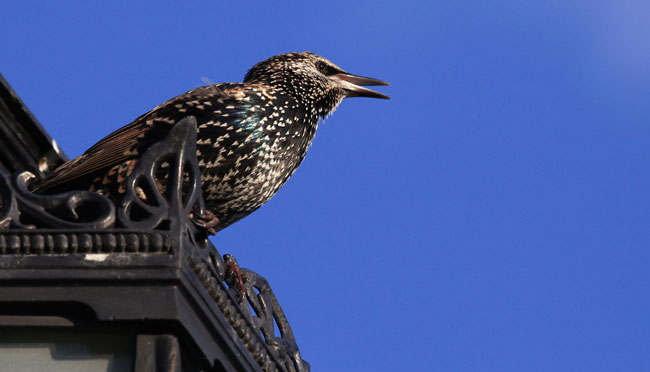Noisy and Messy Starling Winter Roosts
By Chris Williams on December 2, 2013.
Question
I live in an apartment building. All of a sudden it seems we have this flock of starlings that are hanging out in a big tree right outside my balcony. They’re incredibly loud in the evening and bird poop is making a real mess on my balcony and the side of the building. The manager says there’s really nothing they can do about it. Couldn’t he scare them away or something?
Answer
Starling roosts are a winter phenomenon that results in lots of complaints from those nearby. Winter flocks of starlings are much larger than summer flocks and concentrated in a smaller area. The flocks are usually a combination of starlings and blackbirds, and may include grackles and cowbirds.
Some starlings migrate out of their summer roosts in fall, but many remain as winter residents. Those that stay will usually shift their primary roosting area from trees to buildings as the trees lose their leaves, but trees can still serve as staging areas before starlings move to the actual roosts. What you’re witnessing is probably pre-roost behavior.
Starlings don’t feed in the same area where they roost. They typically leave their nighttime roosting area at dawn and will travel up to 30 miles to their feeding area. They then return to their nighttime roosts just before sundown. As they approach the night roost, they go through a pre-roosting behavior by first landing on nearby trees or power lines, bridges, etc. but not on their actual roost site. They remain in these pre-roost sites until after sundown and can make a lot of noise while there. When they move to their primary nighttime roost, they will often repeatedly circle, then settle, then rise and circle again before eventually settling in for the evening.
The starlings may be actually roosting in that tree for the night if it’s an evergreen offering protection, or they may be spending the night on your apartment building, either on ledges, on the roof, or under the roof overhang. Or, they may be roosting nearby, often in a park. In cities, they like to roost in dark areas that are just beyond a circle of light. If there are high lights on a building, the birds will roost in a dark area of the building protected from weather and above the lights.
Frightening Techniques May Not Scare Starlings Away
Frightening devices like noisemakers or distress calls sometimes work against starlings, but they often don’t. Birds that are used to people and city noises may not be affected. Harassing birds to make them leave a roost is an involved process that should only be done by professionals.
If the birds are actually roosting on your building, there are deterrents that can be installed to make the roost site less desirable. Repellents and porcupine wire, prongs, netting, and electric wire can discourage roosting on ledges and other building surfaces. At Colonial, we’ve been doing pest bird management for more than 25 years. Our expert technicians can even advise on building modifications that will permanently protect your building from roosting starlings
